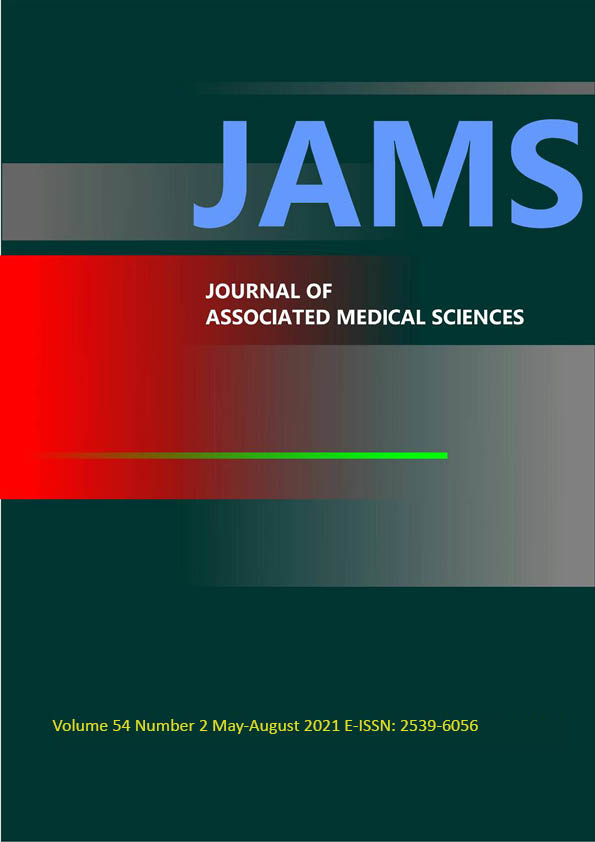A preliminary performance evaluation of 3D facial image reconstruction from computed tomography scan
Main Article Content
Abstract
Background: As a result of all kinds of disasters, people might be injured or killed. Most people could not be able to identify their family members dying in disasters. 3D facial image reconstruction from skull could narrow down the recognition of the faces from their family or close friends.
Objectives: The purpose of this preliminary study is to receive facial soft tissue thickness for forming a preliminary database and to create a 3D facial image reconstruction from Thai people.
Materials and methods: 3D facial image reconstruction based on facial soft tissue thickness data and paranasal sinuses CT scan images from Thai people was studied. Firstly, 15 anatomical facial landmarks to form a facial soft tissue thickness data were collected from Maharaj Nakorn Chiang Mai hospital CT scan database, 45 cases were used (22 males and 23 females). A 3D skull model matrix from CT scan DICOM files was then generated. Finally, the 3D facial soft tissue model matrix was combined with the 3D skull model matrix to create a 3D facial image reconstruction.
Results: The result showed Thai male facial soft tissue was thicker than the female at mid-philtrum and rhinion, respectively. Median values of 15 landmarks were used to create a 3D facial skin on a 3D skull. The random survey of 100 people showed 11% matched a 3D facial image reconstruction with a real 3D face of that skull.
Conclusion: The results also revealed that some people could recognize the real faces from the 3D facial images through facial soft tissue on the skull without any facial organs such as eyes, nose, or lips. It is suggested that facial soft tissue sampling and other facial organ studies could be helpful to create a big database for rebuilding more perfectly facial reconstruction in Thai people.
Article Details

This work is licensed under a Creative Commons Attribution-NonCommercial-NoDerivatives 4.0 International License.
Personal views expressed by the contributors in their articles are not necessarily those of the Journal of Associated Medical Sciences, Faculty of Associated Medical Sciences, Chiang Mai University.
References
Wilkinson C. Computerized forensic facial reconstruction: a review of current systems. Forensic Sci Med Pathol 2005; 1(3): 173-77.
Cavanagh D, Steyn M. Facial reconstruction: soft tissue thickness values for South African black females. Forensic Sci Int 2011; 206: 215.e1-7.
Ayoub F, Saadeh M, Rouhana G, Haddad R. Midsagittal facial soft tissue thickness norms in an adult Mediterranean population. Forensic Sci Int 2019; 294: 217.e1-7.
Wang J, Zhao X, Mi C, Raza I. The study on facial soft tissue thickness using Han population in Xinjiang. Forensic Sci Int 2016; 266: 585.e1-5.
Panenková P, Beňuš R, Masnicová S, Obertová Z, Grunt J. Facial soft tissue thicknesses of the mid-face Slovak population. Forensic Sci Int 2012; 220(1-3): 293.e1-6.
Tedeschi-Oliveira SV, Melani RF, de Almeida NH, de Paiva LA. Facial soft tissue thickness of Brazilian adults. Forensic Sci Int 2009; 193(1-3): 127.e1-7.
Shui W, Zhou M, Deng Q, Wu Z, Ji Y, Li K, He T, Jiang H. Densely calculated facial soft tissue thickness for craniofacial reconstruction in Chinese adults. Forensic Sci Int 2016; 266: 573.e1-12.
Dong Y, Huang L, Feng Z, Bai S, Wu G, Zhao Y. Influence of sex and body mass index on facial soft tissue thickness measurements of the northern Chinese adult population. Forensic Sci Int 2012; 222(1-3): 396.e1-7.
Prieels F, Hirsch S, Hering P. Holographic topometry for a dense visualization of soft tissue for facial reconstruction. Forensic Sci Med Pathol 2009; 5(1): 11-16.
Sipahioğlu S, Ulubay H, Diren HB. Midline facial soft tissue thickness database of Turkish population: MRI study. Forensic Sci Int 2012; 219(1-3): 282.e1-8.
Verzé L. History of facial reconstruction. Acta Biomed 2009; 80(1): 5-12.
Puavaranukroh P and Srettabunjong S. Facial Soft Tissue Thickness in Thai Adults Cadavers, Vajira Med J 2010; 54(3): 267-79 [in Thai].
Suazo GIC, Cantín LM, Zavando MDA, Perez RFJ, Torres MSR. Comparisons in soft-tissue thicknesses on the human face in fresh and embalmed corpses using needle puncture method. Int J Morphol 2008; 26(1):165-69.
Fourie Z, Damstra J, Gerrits PO, Ren Y. Accuracy and reliability of facial soft tissue depth measurements using cone beam computer tomography. Forensic Sci Int 2010; 199(1-3): 9-14.
Sirisin J. Exploratory study of facial soft tissue thickness in North Eastern Thai adults [Thesis]. Graduate school: Khon Kaen University; 2011 [in Thai].
Chung JH, Chen HT, Hsu WY, Huang GS, Shaw KP. A CT-scan database for the facial soft tissue thickness of Taiwan adults. Forensic Sci Int 2015; 253:132.e1-11.
Tilotta F, Richard F, Glaunès J, Berar M, Gey S, Verdeille S, et al. Construction and analysis of a head CT-scan database for craniofacial reconstruction. Forensic Sci Int 2009; 191(1-3): 112.e1-12.
Wilkinson C, Rynn C, Peters H, Taister M, Kau CH, Richmond S. A blind accuracy assessment of computer-modeled forensic facial reconstruction using computed tomography data from live subjects. Forensic Sci Med Pathol 2006; 2(3): 179-87.


